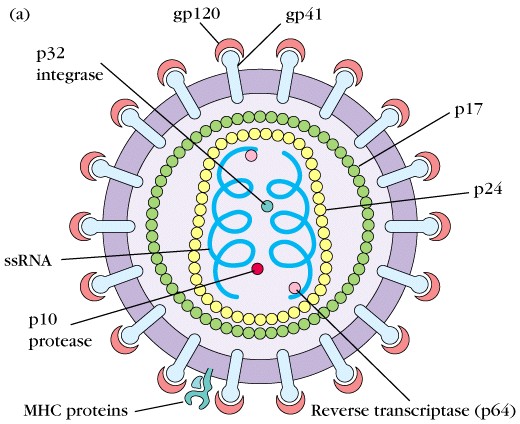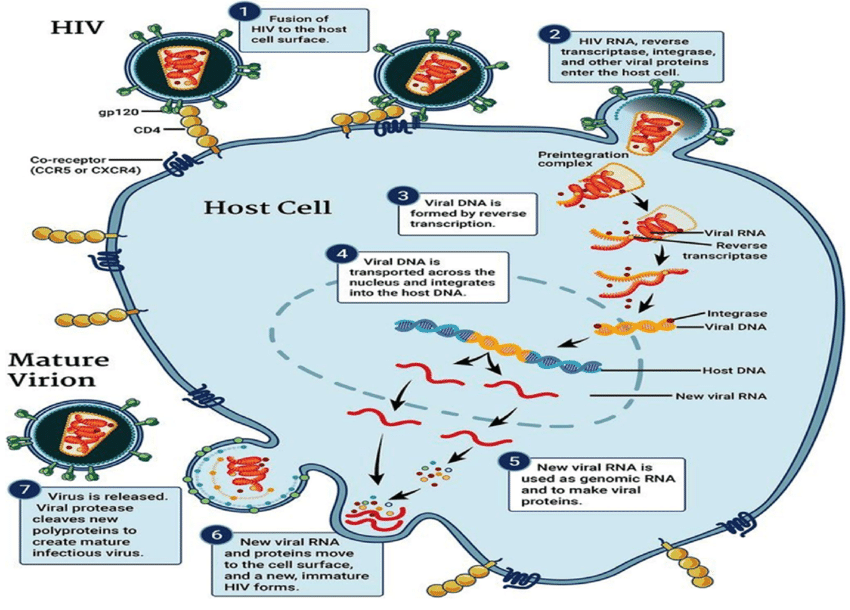HIV/AIDS Study Guide
Introduction
Every time you run a fever, your immune system raises the body’s temperature to kill the infection. Our immune system is responsible for killing off any infections that try to invade our bodies.
The HIV virus slowly destroys the immune system by damaging white blood cells and it leads to AIDS if not treated on time. Luckily, if HIV is caught, it is fairly easy to cure with a concoction of antibiotics.

What is HIV?
HIV’s full form is Human Immunodeficiency Virus. It is a virus that damages our immune system and can develop into AIDS which in turn makes infected people’s health very fragile and vulnerable to other diseases.
It is spread when an infected person’s bodily fluids meet a healthy person’s bloodstream. These fluids are:
- Blood
- Semen
- Vaginal fluids
- Breast milk
For transmission to occur, the HIV virus in these fluids must get into the bloodstream of an HIV-negative person through a mucous membrane (found in the rectum, vagina, mouth, or tip of the penis), open cuts, or by direct injection.
HIV Structure
- The virus has a spherical form to it.
- The virus is made up of a capsid core that houses the genetic information and is encased in a protein envelope.
- Many spikes of a glycoprotein can be seen on the protein membrane.
- Gp120, the outer component of the glycoprotein, is connected to gp41, the interior part of the glycoprotein.
Other proteins, including certain HLA antigens, are found in the HIV envelope (Human Leukocyte Antigen). Two folded helices of RNA molecules are found in HIV’s genome. The reverse transcriptase enzyme is present, and it is responsible for the conversion of RNA to DNA. Another enzyme called integrase aids in the integration of the viral DNA into the host cell.
HIV Virus: Life Cycle
HIV affects T-helper cells, which are a kind of white blood cell in the immune system (also called a CD4 cell). HIV is incapable of self-replication. Instead, the virus latches to a T-helper cell and combines with it. It then takes over the DNA of the cell, multiplies within it, and eventually releases more HIV into circulation.
How does HIV become AIDS?
The full form of AIDS is Acquired Immunodeficiency Syndrome. It is the most extreme stage of HIV and is preventative, in the event that the HIV infection is found and caught early.
- HIV destroys white blood cells (CD4 T-cells) that help your body fight off invading infections.
- AIDS is diagnosed if the infection goes unnoticed and the CD4 T-cell count drops below 200. This process usually takes years.
How does HIV spread?
For a healthy person to get infected by HIV, they need to contact an infected person directly. Some ways in which HIV spreads are:
- Sex: Vaginal, anal, or oral sex with an infected partner puts one at serious risk. Blood, semen, or vaginal secretions entering your body can immediately become infected from the infected partner. It is important to get regularly tested and practice safe sex.
- Needles: Sharing contaminated needles and syringes puts you at high risk of HIV.
- Blood Transfusions in unsterilized conditions
- Pregnancy or delivery or through breast-feeding: Infected mothers can pass the virus on to their babies.
Ordinary contact cannot spread HIV. You cannot catch HIV or AIDS by kissing, hugging, or shaking hands with someone who has the infection. HIV is also not airborne or waterborne.
Common diseases caused by HIV/AIDS
- PCP (pneumocystis pneumonia): A fungal infection that is common among HIV patients
- Thrush: Causes inflammation and a thick coating on your tongue, mouth, esophagus, or vagina
- Tuberculosis: Leading cause of death among AIDS patients
Cancers common to HIV/AIDS
- Lymphoma: Starts in the white blood cells and leads to lymph nodes on the neck, groin, and armpit.
- Kaposi’s Sarcoma: Causes pink or red lesions on the skin and mouth
Other diseases:
- Neurological complications: Can cause forgetfulness, anxiety, difficulty in walking, and confusion
- Kidney Disease: HIV-associated nephropathy (HIVAN) causes inflammation of your kidneys
- Liver Disease: Especially seen in people who have hep A and C
Prevention for HIV AIDS
- Use treatment as prevention (TasP): Taking HIV medication can keep your partner from becoming infected with the virus. TasP requires adhering to strict prescriptions and regular check-ups.
- Use a new condom every time: Every time you have anal or vaginal sex, make sure you use a clean, fresh condom. Lubricants must be water-based; oil-based lubricants can weaken condoms and even lead to breakage.
- Use a clean needle: Always use a sterile needle and discard it properly after use.
- If you’re pregnant, get medical care right away: HIV-positive mothers can pass the virus to the baby, but receiving treatments can dramatically cut the baby’s risk.
Conclusion:
- HIV, if untreated, can lead to the devastating disease AIDS.
- It is easy to treat HIV early; antibiotics do the trick.
- But HIV is very hard to diagnose since the symptoms are modest and don’t appear prominently.
- However, prevention is always better than cure.
- Unprotected sex and sharing needles (whether for drugs or medical purposes) is a big no-no to protect yourself from this virus.
FAQs:
1. What are AIDS and HIV?HIV is Human Immunodeficiency Virus, ravaging the human immune system.AIDS has acquired immunodeficiency syndrome and is the most severe stage of HIV
2. How many types of HIV are there?There are two types of HIV:· HIV-1 is the most common type of HIV worldwide: 95% of all HIV cases.· HIV-2 is far rarer: 5% of all HIV cases HIV-2 is also prevalent in West Africa and is harder to spread from person to person. Its incubation period is also longer.
3. What are the 4 stages of HIV?
Primary infection (Acute HIV)
- Infected people display flu-like illness within two to four weeks
- Lasts for a few weeks.
Clinical latent infection (Chronic HIV)
- Many infected people may not show any symptoms
- This stage can last for many years if you’re not receiving antiretroviral therapy (ART). Some people develop more severe diseases much sooner.
Symptomatic HIV infectionMild infections or chronic signs and symptoms can be seen. Examples include:
- Fever
- Diarrhea
- Fatigue
- Swollen lymph nodes
- Weight loss
4. What type of virus is AIDS?
Human Immunodeficiency Virus (HIV) causes AIDS, a potentially deadly disease that affects the body’s immune system.
We hope you enjoyed studying this lesson and learned something cool about HIV- AIDS! Join our Discord community to get any questions you may have answered and to engage with other students just like you! Don’t forget to download our App to experience our fun, VR classrooms – we promise, it makes studying much more fun! 😎
Sources:
- HIV/AIDS. https://middlesexhealth.org/learning-center/diseases-and-conditions/hiv/aids. Accessed on 30 Nov, 2021.
- HIV/AIDS. https://www.stclair.org/services/mayo-clinic-health-information/diseases-and-conditions/CON-20373504/. Accessed on 30 Nov, 2021.
- HIV/AIDS. https://www.mayoclinic.org/diseases-conditions/hiv-aids/symptoms-causes/syc-20373524. Accessed on 30 Nov, 2021.
- HIV/Prep. https://www.mdprogressivecare.com/hiv/prep. Accessed on 30 Nov, 2021.
- STI’s/HIV/AIDS. http://www.ndhealth.gov/familyplanning/stis-hiv-aids/. Accessed on 30 Nov, 2021.
- How Do You Get or Transmit HIV?. https://www.hiv.gov/hiv-basics/overview/about-hiv-and-aids/how-is-hiv-transmitted. Accessed on 30 Nov, 2021.
- HIV AIDS. https://flexbooks.ck12.org/cbook/ck-12-biology-flexbook-2.0/section/13.54/primary/lesson/hiv-and-aids-bio/. Accessed on 30 Nov, 2021.


